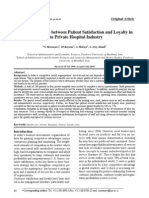Registration 1
Registration 1
Uploaded by
Gupta PrkCopyright:
Available Formats
Registration 1
Registration 1
Uploaded by
Gupta PrkCopyright
Available Formats
Share this document
Did you find this document useful?
Is this content inappropriate?
Copyright:
Available Formats
Registration 1
Registration 1
Uploaded by
Gupta PrkCopyright:
Available Formats
Annexure-1
Managing customer perceived service quality in private healthcare sector in India
1. Introduction
Health and economic developments are so closely related that it is impossible to achieve one without the other. While the economic development in India is gaining momentum over the past few decades, our health system is at cross roads today (Ramani & Dileep, 2005). In this regard, health and health care need to be distinguished from each other for no better reason than that the former is often incorrectly seen as a direct function of the later. Proper healthcare is an indispensable basis for defining a societys sense of well being (Srinivasan. 2005). Health care covers not merely medical care but also all aspects of pro preventive care too. It has no longer limited to care rendered by or financed by government sector alone but recent time has seen massive participation of private players. Private sector in health care has gained a dominant presence in all the areas like medical education, sale of pharmaceuticals, construction of hospitals, and providing medical services etc. At the same time superior service quality in private health care sector has been a major concern as customers have to pay a huge amount of money and effort to avail the services. Like all other service sectors, the healthcare sector, particularly private healthcare units, have recognised the importance of relationship marketing. They have moved beyond patient satisfaction and perceived quality of care, to build mutually committed relationships and loyalty with the stakeholders (Peltier, Boyt and Schibrowsky, 2000) to develop better understanding of patient-provider relationships and establish long-term patient-provider bond. Health care service marketers have experienced that competition can be well managed by differentiating through service quality vis-a vis competitors. Service quality describes a comparison of expectations with performance of service delivery (Lewis & Booms, 1983) when customer encounters the service personnel. Customer satisfaction with service quality is defined by comparing perceptions of service received with the perception of expected service of the consumers. Present days quality has emerged as a major competitive element in healthcare service strategies. Perceived service quality mainly deals with the three issues. First it compares the gap model with the performance model; next it investigates the direction of causality between service quality and satisfaction. Finally it examines whether the influence of dimensions of the service quality vary across service type industries.
While patient interests are a fundamental part of service quality in modern health care systems, Grol et al. (2000) noted that care providers often react to patients on the basis of their own subjective perceptions of patients needs and experiences that often prove to be wrong. Alaloola and Albedaiwi (2008) observed that traditionally, managing service quality in health care entails such activities as checking providers credentials if they are qualified or not to provide the services; auditing clinical activities for the purposes of checking if clinical guidelines and protocols are being followed; auditing medical records as well as measuring outcomes in terms of whether the patients get better or not. The primary focus tends to be to protect patients from substandard care. The major problem however with the traditional way of managing quality in health services lies in its heavy reliance on technical clinical criteria and the absence of customers view on the services provided(Lee et al, 2000).. Because of this gap in the literature in the past, this research work is proposed to have a better understanding and managing the service quality perceptions possessed by both recipients and providers when shaping the healthcare delivery system 2. Proposed research questions & objectives:
Very few studies have sought to evaluate the service provider understanding of the patients perceptions of health service quality (OConnor et al., 1994), and again few studies of perceived private healthcare service quality have been undertaken (Sanchez-Perex et al., 2007). Brown (2006) highlighted that the patient is becoming an ever more silent partner in the health care system, as their views of quality have largely been side lined by the number of attempts to exclusively determine patient satisfaction with health care. Research that focuses on strengthening our understanding of the meaning, measurement, and management of perceived service quality from the patients perspective in healthcare is now arguably paramount. The research questions which are formulated to carry out the research in proper direction are: 1. What are the factors effecting the service quality of the private healthcare organisations? 2. How is customer satisfaction related to perceived service quality? 3. What is relationship between the perceived service quality of customers and corporate image and in the private health care sector? The objectives of the study are: To find out and study the diverse factors affecting service quality in healthcare industry. To identify causes of service failure and the process of service recovery in private healthcare industry. To study relationships between perceived service quality, patient satisfaction and behavioural intentions of service providers. To develop an instrument to measure perceived service quality in the private health care industry.
For the purpose of the present study, the following hypothesis has been derived on the basis of the literature reviewed. There exist a significant relationship between customer satisfaction and perceived service quality of customer in private healthcare sector There exist a significant relationship between customer loyalty and perceived service quality of customer in private healthcare sector There exist a significant relationship between service failure and perceived service quality of customer in private healthcare sector There exist a significant relationship between and perceived service quality of customer in private and corporate image 3. Proposed research methodology
Research methodology of the study includes identification of the research problem, formulation of hypothesis, collection of data, correlation of the data, and projection of the outcomes of the study through analysis Research design The proposed study will be an empirical one which is purely based on primary and secondary information collected from private healthcare organisation. Data source Data will be collected from the primary and secondary sources for analysis and interpretation and to justify the relevance of this study. Sampling Selection of the sample will be based on convenience sampling method and attempt will be made for reciprocal representation of respondents from customers & service providers of private health care sector. Methods of data collection Data collection Methods like direct observation, interviews, structured schedules, focused group discussions, etc. will be deployed to get value added information for the study. Data analysis Data will be analysed using SPSS package and the tools such as descriptive statistics, factor analysis, ANOVA, regression & correlation, and Structural Equation Modelling will be applied to draw meaningful conclusion of the study. 4. Anticipated outcome from research The piece of research may suggest for sound relationship mechanism between service quality management dimensions (quality management and patient service quality) and their impact on performance of the healthcare organizations. It may recommend the organizations to deliver service as perceived by customers. Further it may broaden their examination of quality from the conventional organizationoriented perspective to a dual, organization customer perspective. It may focus on the need for strategic determinants to improve service quality and performance, and to develop as performance excellence strategies. These strategies will then promote continuous performance improvement in quantity, quality and equity of service provision.
5. Tentative time line for research Description Steps 1 Preparation of the research scope document and broad objectives 2 Literature review and development of models for competency based performance management system 3 Preparation of questionnaires for collection of data from research units 4 Preparation of questionnaires for collection of data from research units 5 Data Analysis and Model Validation 6 Collection of Feedback from Industries 7 Preparation of Draft Synopsis 8 Comments and Feedback on Draft and Synopsis 9 Submission of Final Thesis
Methodology
Duration 2 months
Secondary research
6 months
4 months Data Analysis 4 months 4 months 4 months 4 months 4 months 4 months 36 months
Total References
Alaloola N, Albedaiwi W (2008). Patient satisfaction in a Riyadh tertiary care centre. Int. J. Health Care Qual. Assur., 21(7): 630-637. Brown,T.M., Cueto, M. and Fee,E.(2006), The world health organization and transition from "international" to "global" public health, American Journal of Public health, 96, 62-72. Grol R, Wensing M, Mainz J, Jung H, Ferreira P, Hearnshaw H, Hjortdahl P, Olesen F, Reis S, Ribacke M, Szecsenyi J (2000). Patients in Europe evaluate general practice care: An international comparison. Br. J. Gen. Pract., 50:882-887. Lee, Hanjoon, Delene, Linda M., Bunda, Mary Anne, Kim, Chankon (2000), Methods of measuring health-care service quality, Journal of Business Research 48, 233-246 Lewis, R.C., and B.H. Booms (1983), The marketing aspects of service quality, in: E merging perspectives on services marketing, L. Berry, G. Shostack, and G. Upah (eds.), Chicago: American Marketing, 99-107. OConor, Stephen J., Shewchuk, R.M. and Carney, Lynn (1994). The great gap, Journal of Health Care Marketing, 14 (2), 32-39. Peltier, James W, Thomas Boyt and John A Schibrowsky (2000), Obstetrical Care and Patient Loyalty, Marketing Health Services, Fall, pp.5 - 12. Srinivisan, R.(2005). Health care in India - vision 2020, Issues and prospects, McMillan, New Delhi Ramani, K. V., Dilip, R. (2006). Managing hospital supplies: Process reengineering at Gujarat Cancer Research Institute, India, Journal of Health Organization & Management, 20(2-3), 218-226.
You might also like
- Complex, Pakistan BY Muhammad Ali (Baskent University Ankara) & Majid Khan (Yildirim Beyazit University Ankara)No ratings yetComplex, Pakistan BY Muhammad Ali (Baskent University Ankara) & Majid Khan (Yildirim Beyazit University Ankara)22 pages
- Assessment of Service Quality Dimensions in Healthcare Industry "A Comparative Study On Patient's Satisfaction With Mayiladuthurai Taluk Government vs. Private HospitalsNo ratings yetAssessment of Service Quality Dimensions in Healthcare Industry "A Comparative Study On Patient's Satisfaction With Mayiladuthurai Taluk Government vs. Private Hospitals9 pages
- Assessment of Service Quality Dimensions in Healthcare Industry A Study On Patient's Satisfaction With Bangladeshi Private HospitalsNo ratings yetAssessment of Service Quality Dimensions in Healthcare Industry A Study On Patient's Satisfaction With Bangladeshi Private Hospitals9 pages
- Health Care Quality Assessment: Michael A. Counte, PH.DNo ratings yetHealth Care Quality Assessment: Michael A. Counte, PH.D30 pages
- The Relationship Between Hospital Administration and Quality of Services: Meta-AnalysisNo ratings yetThe Relationship Between Hospital Administration and Quality of Services: Meta-Analysis9 pages
- Measurement of patient satisfaction with community pharmacyNo ratings yetMeasurement of patient satisfaction with community pharmacy13 pages
- In Patient Satisfaction Survey-How Does It Help Our Health Care Delivery System (The Patient, The Health Care Giver and The Organization) ?No ratings yetIn Patient Satisfaction Survey-How Does It Help Our Health Care Delivery System (The Patient, The Health Care Giver and The Organization) ?10 pages
- Patients Satisfaction: To Analyse The Patients Satisfaction Towards The Treatment by The HospitalNo ratings yetPatients Satisfaction: To Analyse The Patients Satisfaction Towards The Treatment by The Hospital4 pages
- Consumer Perception On Service Quality in Health Care SectorNo ratings yetConsumer Perception On Service Quality in Health Care Sector4 pages
- To Find Out The Relationship Between Service Quality and Customer Satisfaction in Hospitals100% (1)To Find Out The Relationship Between Service Quality and Customer Satisfaction in Hospitals30 pages
- NSS October to December 2023 Vol. 1-PagesNo ratings yetNSS October to December 2023 Vol. 1-Pages4 pages
- A comparative study on Service Quality in Private and Public Hospitals in Madhya Pradesh.No ratings yetA comparative study on Service Quality in Private and Public Hospitals in Madhya Pradesh.4 pages
- The Impact of The Payment of The Nursing Fee On The Quality of Clinical Services and The Satisfaction of Service RecipientsNo ratings yetThe Impact of The Payment of The Nursing Fee On The Quality of Clinical Services and The Satisfaction of Service Recipients18 pages
- Hospital Study - Relationship BTWN Emp. Satisfaction and Pt. ExperiencesNo ratings yetHospital Study - Relationship BTWN Emp. Satisfaction and Pt. Experiences31 pages
- ROLE OF PATIENT SATISFACTION SURVEYS IN ENHANCING HEALTHCARE QUALITYNo ratings yetROLE OF PATIENT SATISFACTION SURVEYS IN ENHANCING HEALTHCARE QUALITY38 pages
- Patients Satisfaction and Its DeterminanNo ratings yetPatients Satisfaction and Its Determinan12 pages
- COMM201.PSW. CAHRLIE - QUINONES.Assignment3#No ratings yetCOMM201.PSW. CAHRLIE - QUINONES.Assignment3#2 pages
- Home October/December 2005 - Volume 30 - Issue 4No ratings yetHome October/December 2005 - Volume 30 - Issue 414 pages
- A Study On Service Quality With Special Reference To Almas Hospital KottakkalNo ratings yetA Study On Service Quality With Special Reference To Almas Hospital Kottakkal18 pages
- Enhancing Care Standard at Public Healthcare Facilities Through Patient Satisfaction Assessment - A ReviewNo ratings yetEnhancing Care Standard at Public Healthcare Facilities Through Patient Satisfaction Assessment - A Review5 pages
- Patient' Satisfaction and Quality of Healthcare: Case of Hospitals in Ho Chi Minh CityNo ratings yetPatient' Satisfaction and Quality of Healthcare: Case of Hospitals in Ho Chi Minh City16 pages
- 4 The Measurement of Service Quality in HealthcareNo ratings yet4 The Measurement of Service Quality in Healthcare14 pages
- Piyawan,+4 JSCM 12 (1) June+2018 Factors+Affecting+Patient+Satisfaction AunthikarnNo ratings yetPiyawan,+4 JSCM 12 (1) June+2018 Factors+Affecting+Patient+Satisfaction Aunthikarn16 pages
- Asamrew (2020) Level of Patient Satisfaction With Inpatient Services and Its Determinants A Study of A Specialized Hospital in EthiopiaNo ratings yetAsamrew (2020) Level of Patient Satisfaction With Inpatient Services and Its Determinants A Study of A Specialized Hospital in Ethiopia12 pages
- A Study On The Impact of Healthcare Service Quality On Patient Satisfaction and Loyalty in Select Public and Private HospitalsNo ratings yetA Study On The Impact of Healthcare Service Quality On Patient Satisfaction and Loyalty in Select Public and Private Hospitals10 pages
- Building Patient Loyalty in Pharmacy Service A Comprehensive ModelNo ratings yetBuilding Patient Loyalty in Pharmacy Service A Comprehensive Model10 pages
- A Study On Patient Satisfaction in Outpatient Department Private Hospital - Chennai Ijariie6483100% (1)A Study On Patient Satisfaction in Outpatient Department Private Hospital - Chennai Ijariie648311 pages
- COMM201.PSW. CAHRLIE - QUINONES.Assignment3 1No ratings yetCOMM201.PSW. CAHRLIE - QUINONES.Assignment3 12 pages
- Mohammed Akram 7 September, 2019 MGT 5103 - Article Review ProfessorNo ratings yetMohammed Akram 7 September, 2019 MGT 5103 - Article Review Professor5 pages
- A Study On Impact of Patient's Preferences On Service Quality of The Hospitals With Special Reference To Thanjavur District, TamilnaduNo ratings yetA Study On Impact of Patient's Preferences On Service Quality of The Hospitals With Special Reference To Thanjavur District, Tamilnadu12 pages
- Ding Et Al. - 2019 - Effect of Patient Participation On Nurse and Patient Outcomes in Inpatient HealthcareNo ratings yetDing Et Al. - 2019 - Effect of Patient Participation On Nurse and Patient Outcomes in Inpatient Healthcare16 pages
- A Study of Patient Satisfaction Level in Out Patient Department (OPD) in A Tertiary Care Hospital in MaharashtraNo ratings yetA Study of Patient Satisfaction Level in Out Patient Department (OPD) in A Tertiary Care Hospital in Maharashtra9 pages
- Patient's Satisfaction With Nursing Care Provided in Selected Areas of Tertiary Care Hospital 1No ratings yetPatient's Satisfaction With Nursing Care Provided in Selected Areas of Tertiary Care Hospital 113 pages
- Understanding Quality and Satisfaction in Public Hospital Services - A Nationwide Inpatient Survey in GreeceNo ratings yetUnderstanding Quality and Satisfaction in Public Hospital Services - A Nationwide Inpatient Survey in Greece6 pages
- Strategies to Explore Ways to Improve Efficiency While Reducing Health Care CostsFrom EverandStrategies to Explore Ways to Improve Efficiency While Reducing Health Care CostsNo ratings yet
- Textbook of Urgent Care Management: Chapter 41, Measuring and Improving Patient SatisfactionFrom EverandTextbook of Urgent Care Management: Chapter 41, Measuring and Improving Patient SatisfactionNo ratings yet
- Strategic Managment in PTCL: Group MembersNo ratings yetStrategic Managment in PTCL: Group Members18 pages
- DAVP's Empanelled Advertising Agencies (Engaged in Multi Media Creative Work) Category-ANo ratings yetDAVP's Empanelled Advertising Agencies (Engaged in Multi Media Creative Work) Category-A6 pages
- Strategic Positioning For Competitive Advantage: A. Tony Prasetiantono Week 11No ratings yetStrategic Positioning For Competitive Advantage: A. Tony Prasetiantono Week 1121 pages
- Role of Marketing in Strategic Planning: Mr. Vimal A ShuklaNo ratings yetRole of Marketing in Strategic Planning: Mr. Vimal A Shukla45 pages
- BRAND: Shan Salt: 2. Find Three Print Ads or TVC'S, Focusing OnNo ratings yetBRAND: Shan Salt: 2. Find Three Print Ads or TVC'S, Focusing On3 pages
- 2008 Homburg, Jensen & Krohmer - Configurations of Marketing and Sales - A Taxonomy (DV) PDFNo ratings yet2008 Homburg, Jensen & Krohmer - Configurations of Marketing and Sales - A Taxonomy (DV) PDF24 pages
- Dnyansagar Institute of Management and Research Mba-Ii / Sem-Iii / Strategic Management Course Name: Strategic Management Code: 301No ratings yetDnyansagar Institute of Management and Research Mba-Ii / Sem-Iii / Strategic Management Course Name: Strategic Management Code: 3013 pages
- 01 Defining Marketing For The New RealitiesNo ratings yet01 Defining Marketing For The New Realities44 pages
- Designing and Integrated Marketing ChannelsNo ratings yetDesigning and Integrated Marketing Channels34 pages
- Complex, Pakistan BY Muhammad Ali (Baskent University Ankara) & Majid Khan (Yildirim Beyazit University Ankara)Complex, Pakistan BY Muhammad Ali (Baskent University Ankara) & Majid Khan (Yildirim Beyazit University Ankara)
- Assessment of Service Quality Dimensions in Healthcare Industry "A Comparative Study On Patient's Satisfaction With Mayiladuthurai Taluk Government vs. Private HospitalsAssessment of Service Quality Dimensions in Healthcare Industry "A Comparative Study On Patient's Satisfaction With Mayiladuthurai Taluk Government vs. Private Hospitals
- Assessment of Service Quality Dimensions in Healthcare Industry A Study On Patient's Satisfaction With Bangladeshi Private HospitalsAssessment of Service Quality Dimensions in Healthcare Industry A Study On Patient's Satisfaction With Bangladeshi Private Hospitals
- Health Care Quality Assessment: Michael A. Counte, PH.DHealth Care Quality Assessment: Michael A. Counte, PH.D
- The Relationship Between Hospital Administration and Quality of Services: Meta-AnalysisThe Relationship Between Hospital Administration and Quality of Services: Meta-Analysis
- Measurement of patient satisfaction with community pharmacyMeasurement of patient satisfaction with community pharmacy
- In Patient Satisfaction Survey-How Does It Help Our Health Care Delivery System (The Patient, The Health Care Giver and The Organization) ?In Patient Satisfaction Survey-How Does It Help Our Health Care Delivery System (The Patient, The Health Care Giver and The Organization) ?
- Patients Satisfaction: To Analyse The Patients Satisfaction Towards The Treatment by The HospitalPatients Satisfaction: To Analyse The Patients Satisfaction Towards The Treatment by The Hospital
- Consumer Perception On Service Quality in Health Care SectorConsumer Perception On Service Quality in Health Care Sector
- To Find Out The Relationship Between Service Quality and Customer Satisfaction in HospitalsTo Find Out The Relationship Between Service Quality and Customer Satisfaction in Hospitals
- A comparative study on Service Quality in Private and Public Hospitals in Madhya Pradesh.A comparative study on Service Quality in Private and Public Hospitals in Madhya Pradesh.
- The Impact of The Payment of The Nursing Fee On The Quality of Clinical Services and The Satisfaction of Service RecipientsThe Impact of The Payment of The Nursing Fee On The Quality of Clinical Services and The Satisfaction of Service Recipients
- Hospital Study - Relationship BTWN Emp. Satisfaction and Pt. ExperiencesHospital Study - Relationship BTWN Emp. Satisfaction and Pt. Experiences
- ROLE OF PATIENT SATISFACTION SURVEYS IN ENHANCING HEALTHCARE QUALITYROLE OF PATIENT SATISFACTION SURVEYS IN ENHANCING HEALTHCARE QUALITY
- A Study On Service Quality With Special Reference To Almas Hospital KottakkalA Study On Service Quality With Special Reference To Almas Hospital Kottakkal
- Enhancing Care Standard at Public Healthcare Facilities Through Patient Satisfaction Assessment - A ReviewEnhancing Care Standard at Public Healthcare Facilities Through Patient Satisfaction Assessment - A Review
- Patient' Satisfaction and Quality of Healthcare: Case of Hospitals in Ho Chi Minh CityPatient' Satisfaction and Quality of Healthcare: Case of Hospitals in Ho Chi Minh City
- 4 The Measurement of Service Quality in Healthcare4 The Measurement of Service Quality in Healthcare
- Piyawan,+4 JSCM 12 (1) June+2018 Factors+Affecting+Patient+Satisfaction AunthikarnPiyawan,+4 JSCM 12 (1) June+2018 Factors+Affecting+Patient+Satisfaction Aunthikarn
- Asamrew (2020) Level of Patient Satisfaction With Inpatient Services and Its Determinants A Study of A Specialized Hospital in EthiopiaAsamrew (2020) Level of Patient Satisfaction With Inpatient Services and Its Determinants A Study of A Specialized Hospital in Ethiopia
- A Study On The Impact of Healthcare Service Quality On Patient Satisfaction and Loyalty in Select Public and Private HospitalsA Study On The Impact of Healthcare Service Quality On Patient Satisfaction and Loyalty in Select Public and Private Hospitals
- Building Patient Loyalty in Pharmacy Service A Comprehensive ModelBuilding Patient Loyalty in Pharmacy Service A Comprehensive Model
- A Study On Patient Satisfaction in Outpatient Department Private Hospital - Chennai Ijariie6483A Study On Patient Satisfaction in Outpatient Department Private Hospital - Chennai Ijariie6483
- Mohammed Akram 7 September, 2019 MGT 5103 - Article Review ProfessorMohammed Akram 7 September, 2019 MGT 5103 - Article Review Professor
- A Study On Impact of Patient's Preferences On Service Quality of The Hospitals With Special Reference To Thanjavur District, TamilnaduA Study On Impact of Patient's Preferences On Service Quality of The Hospitals With Special Reference To Thanjavur District, Tamilnadu
- Ding Et Al. - 2019 - Effect of Patient Participation On Nurse and Patient Outcomes in Inpatient HealthcareDing Et Al. - 2019 - Effect of Patient Participation On Nurse and Patient Outcomes in Inpatient Healthcare
- A Study of Patient Satisfaction Level in Out Patient Department (OPD) in A Tertiary Care Hospital in MaharashtraA Study of Patient Satisfaction Level in Out Patient Department (OPD) in A Tertiary Care Hospital in Maharashtra
- Patient's Satisfaction With Nursing Care Provided in Selected Areas of Tertiary Care Hospital 1Patient's Satisfaction With Nursing Care Provided in Selected Areas of Tertiary Care Hospital 1
- Understanding Quality and Satisfaction in Public Hospital Services - A Nationwide Inpatient Survey in GreeceUnderstanding Quality and Satisfaction in Public Hospital Services - A Nationwide Inpatient Survey in Greece
- Strategies to Explore Ways to Improve Efficiency While Reducing Health Care CostsFrom EverandStrategies to Explore Ways to Improve Efficiency While Reducing Health Care Costs
- Textbook of Urgent Care Management: Chapter 41, Measuring and Improving Patient SatisfactionFrom EverandTextbook of Urgent Care Management: Chapter 41, Measuring and Improving Patient Satisfaction
- DAVP's Empanelled Advertising Agencies (Engaged in Multi Media Creative Work) Category-ADAVP's Empanelled Advertising Agencies (Engaged in Multi Media Creative Work) Category-A
- Strategic Positioning For Competitive Advantage: A. Tony Prasetiantono Week 11Strategic Positioning For Competitive Advantage: A. Tony Prasetiantono Week 11
- Role of Marketing in Strategic Planning: Mr. Vimal A ShuklaRole of Marketing in Strategic Planning: Mr. Vimal A Shukla
- BRAND: Shan Salt: 2. Find Three Print Ads or TVC'S, Focusing OnBRAND: Shan Salt: 2. Find Three Print Ads or TVC'S, Focusing On
- 2008 Homburg, Jensen & Krohmer - Configurations of Marketing and Sales - A Taxonomy (DV) PDF2008 Homburg, Jensen & Krohmer - Configurations of Marketing and Sales - A Taxonomy (DV) PDF
- Dnyansagar Institute of Management and Research Mba-Ii / Sem-Iii / Strategic Management Course Name: Strategic Management Code: 301Dnyansagar Institute of Management and Research Mba-Ii / Sem-Iii / Strategic Management Course Name: Strategic Management Code: 301

























































































